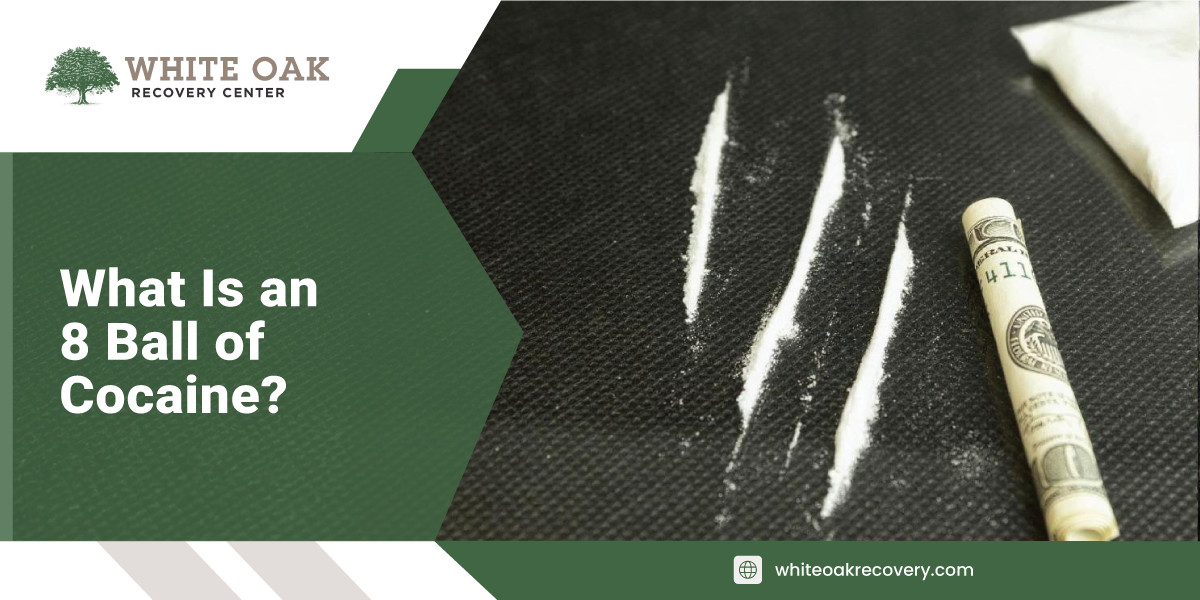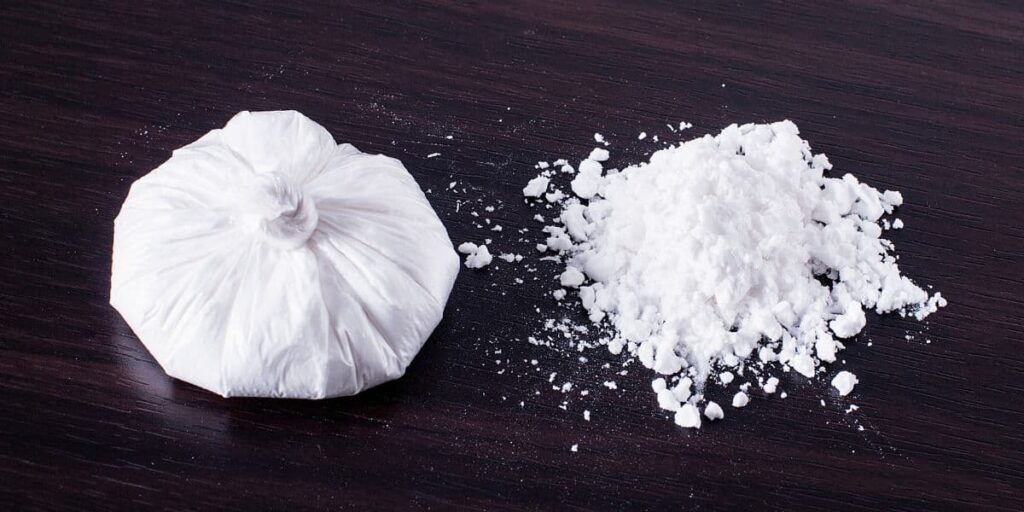What Is an 8 Ball of Cocaine?


Medical Writer:
Reviewer:

Johnny Kim
Executive Psychotherapist
Medical Writer:
Reviewer:

Johnny Kim
Executive Psychotherapist
An 8-ball of cocaine is a term widely recognized in the context of substance abuse and illegal drug use. Knowing what cocaine is, how it looks, how much it costs, and what it does is important for understanding the dangers of its use.
Table of Contents
Toggle
What Is an 8 Ball of Cocaine?
An 8-ball of cocaine refers to a specific quantity of the drug. The term “8 ball” is slang for an eighth of an ounce of cocaine. This is equal to approximately 3.5 grams of cocaine. This quantity is commonly sold on the street and is often used by people who engage in recreational or chronic cocaine use.
The slang word 8-ball comes from the drug scene in the US and is commonly used by people who use or sell cocaine. The amount is a lot, enough for many doses, and is usually used by people who can handle more of the drug. Cocaine is a powerful stimulant that affects the central nervous system. It causes increased energy, alertness, and a sense of happiness.
What Does an 8 Ball of Cocaine Look Like?
An 8-ball of cocaine typically appears as a white powder. The purity and appearance can vary depending on how the cocaine has been processed and whether it has been cut with other substances. When sold on the street, cocaine is often packaged in small plastic bags or wrapped in paper or foil.
The texture of cocaine can range from a fine powder to small crystalline chunks, depending on its purity and the presence of additives. Pure cocaine hydrochloride is a fine, white powder that dissolves easily in water. In contrast, less pure forms may appear off-white or yellowish because of impurities or cutting agents.

What Does an 8 Ball of Cocaine Cost?
The cost of an 8-ball of cocaine can vary significantly based on factors such as geographic location, market conditions, and the purity of the drug. In the United States, the price of an 8-ball typically ranges from $150 to $300. However, the cost may be higher or lower in some areas depending on supply and demand dynamics and law enforcement activities.
Cocaine prices are influenced by the drug’s availability, with larger urban areas often seeing lower prices because of higher supply and competition among dealers. Conversely, the cost may be higher in rural or less populated regions because of limited availability. The purity of the cocaine also plays a crucial role in pricing, with purer forms commanding higher prices.
Side Effects of an 8 Ball of Cocaine
Using an 8-ball of cocaine can have significant short-term and long-term side effects. Cocaine use can make your heart beat faster, raise your blood pressure, give you more energy, and make you feel happy. However, the potential for severe health consequences overshadows these short-term benefits.
Short-Term Side Effects:
- Increased heart rate and blood pressure
- Elevated body temperature
- Dilated pupils
- Increased energy and alertness
- Decreased appetite
- Anxiety and paranoia
The use of large amounts of cocaine, such as an 8-ball, increases the risk of acute side effects like cocaine overdose. Symptoms of an overdose can include seizures, heart attack, stroke, and respiratory failure. Cocaine overdose is a medical emergency and requires immediate attention to prevent fatal outcomes.
Using cocaine often can cause addiction, with a strong urge to seek the drug, even when it causes harm. People who abuse cocaine may have physical and mental problems like muscle twitches, anxiety, paranoia, and severe mood swings.
Risks and Side Effects of Cocaine
Cocaine use disorder is a severe condition characterized by an inability to stop using the drug despite negative consequences. Cocaine use increases the risk of various health problems, including cardiovascular issues, respiratory distress, and neurological damage. Cocaine can harm the brain, causing long-term cognitive problems and raising the chance of mental health issues.
Cocaine abusers often face significant challenges in their daily lives, including strained relationships, financial difficulties, and legal problems. Cocaine can make you feel more energetic and alert, but it can also lead to risky behavior and bad choices. Over time, chronic use can result in severe health issues, including brain damage, anxiety, paranoia, and muscle twitches.
Cocaine is sold on the street in various forms, with white powder being the most common. Drugs are sometimes mixed with other substances. This can complicate treatment and increase the risk of negative effects. Users may not know all the ingredients in the drug they take, causing unexpected and risky reactions.
For those struggling with cocaine addiction, seeking help is crucial. Various treatment options, including medication-assisted treatment (MAT), behavioral therapies, and support groups, can provide the necessary tools and support for recovery. Treating both addiction and mental health issues together can greatly increase the likelihood of long-term recovery.
It is important to know what an 8-ball of cocaine is, how much it costs, its side effects, and the treatment options available. This helps raise awareness about the dangers of cocaine use and supports those struggling with addiction. By promoting education and providing access to effective treatment and support, we can help people struggling with cocaine addiction find the path to recovery.

Cocaine Addiction Treatment and Support at White Oak Recovery Center
If you or a loved one is battling being addicted to cocaine, access to evidence-based addiction treatment is crucial for recovery. White Oak Recovery Center (WORC) provides various effective treatments and therapies that can help you overcome substance abuse, including:
Medication-Assisted Treatment (MAT): While there are no FDA-approved medications specifically for treating cocaine addiction, some medicines used for other conditions may help manage symptoms and cravings. Research is ongoing to identify effective pharmacological treatments for cocaine use disorder.
Behavioral Therapies: Cognitive-behavioral therapy (CBT) and other behavioral interventions have proven effective in treating cocaine addiction. These therapies help you recognize and change negative thought patterns and behaviors associated with substance abuse.
Support Groups: Participation in support groups such as twelve-step facilitation therapy (TSF) can provide you with a sense of community and shared experience. Support groups offer a platform for sharing challenges, successes, and strategies for maintaining sobriety.
Inpatient Treatment Program: Depending on the severity of the addiction, you may be able to benefit from structured treatment programs. Inpatient programs offer intensive, around-the-clock care in a residential setting.
Holistic Approaches: Incorporating holistic practices such as mindfulness, yoga, exercise, and other healthy recreational activities can support overall well-being and aid recovery. These practices help manage stress and improve mental health, contributing to a stronger recovery foundation.
Family Support: Having a strong support system of family and friends is important for recovery. Loved ones can provide encouragement, accountability, and emotional support, helping you stay committed to your recovery goals.
Recognizing the importance of mental health conditions in addiction recovery is also crucial. People with substance use disorders often have co-occurring mental health issues that should be treated as part of their overall treatment plan.
Integrated treatment that addresses both addiction and mental health conditions can improve outcomes and support long-term recovery. At White Oak Recovery Center, we provide dual diagnosis to address and treat co-occurring mental health disorders.
Our treatment specialists at WORC are eager to help you receive compassionate, effective care. Contact us today to discuss your treatment options.

Am I covered for addiction treatment?
Your insurance may cover treatment. Call now for an entirely free and confidential assessment. Recovery starts with a phone call.

Medical Disclaimer:







